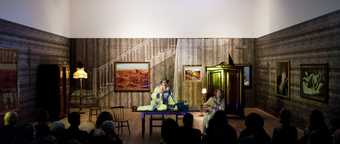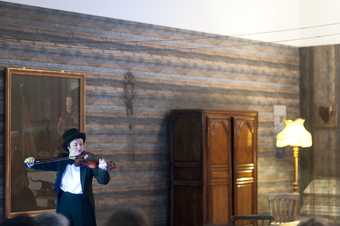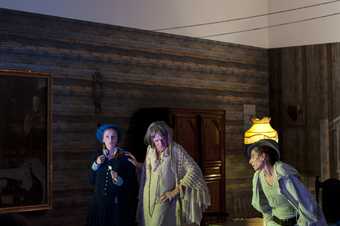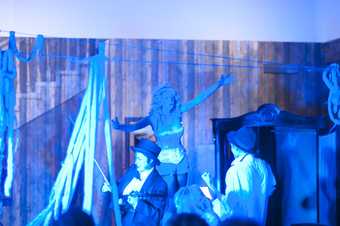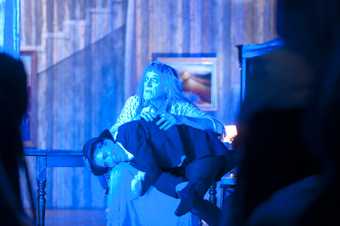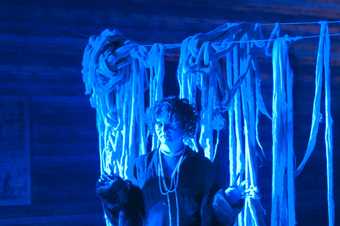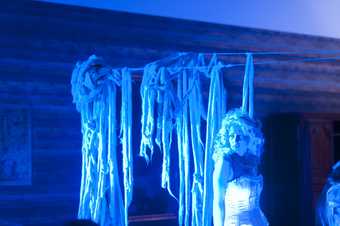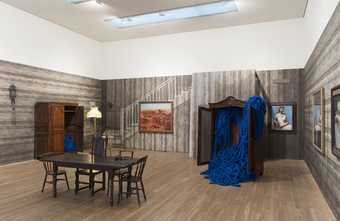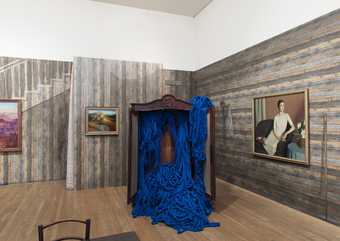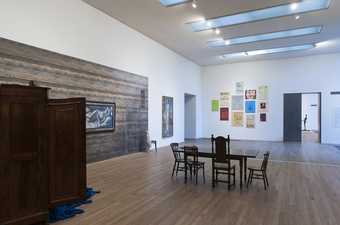In September 2015 Paulina Olowska installed her piece The Mother: An Unsavoury Play in Two Acts and an Epilogue in the Poetry and Dream suite of displays at Tate Modern. After removing the paintings in a gallery, Olowska hung wallpaper on the walls, creating the effect of interior wood panelling. Over this Olowska and two other artists – Paulina Wlostowska and Slawek Lipinski – painted ghostly trompe l’oeil murals of, for example, stairs and curtains, which gave the impression of the inhabitation, with no physical substance. The installation also included period style furniture – a table, chairs, a wardrobe – and was dimly lit by floor lamps. The final layer was a small selection of the paintings from the original display, by artists including Henri Matisse, Dora Carrington and Pablo Picasso. This bourgeois interior provided the backdrop for the performance of Stanislaw Ignacy Witkiewicz’s 1924 surrealist play The Mother: An Unsavoury Play in Two Acts and an Epilogue. The play made reference to the works of August Strindberg and Henrik Ibsen, two playwrights who explored realism but were also concerned with misperception and hallucination.
The live aspect of Olowska’s work, which was performed on three evenings, was an adaptation of Witkiewicz’s play. As well as drawing from the source material, Olowska also looked to other stagings of the play for inspiration, including a 1976 production for television and a cover from the magazine Teatr, which showed a painting based on an image selected from the television production.1 The two main characters, the Mother and her son Leon, were played by professional actors Valerie Cutko and David Gant, and the action centred on their dramatic and manipulative relationship. Through their interactions and conversations, issues such as schizophrenia, madness, drug addiction and alcohol were used to cut through the stable reality of the space, with hallucinations being expressed through off-stage voices, including the voice of the dead Father who occasionally commented on what was happening on stage. Others performed smaller roles, with Olowska playing a violin accompaniment, and her friends and family performing as the maid, the prostitute, the playboy, among others. Gradually these other characters were pulled into the dysfunctional relationship, which climaxed with the mother dying from a cocaine overdose, and the son beginning to go mad with the loss.
In keeping with the title, the performance took place over two acts, with the passing of time indicated by the addition of a large wool hanging above the installation between acts one and two.2
This not only indicated a change in time but also related to the deteriorating mental states of the characters. In the first act the Mother talked about how she earned money by knitting but by the second act she began using this activity as a way to control her life. The large, imposing hanging acted as both a visual representation of her obsessive knitting and a material manifestation of her unstable psyche. The installation functioned as a realistic setting in which the characters interacted and a metaphorical representation of their collective break with reality. The two threads to Olowska’s piece – the installation and the live performance – were intricately bound, and yet pushed against one another, exploring the boundaries of reality. Olowska layered the painters’, the playwright’s and the viewer’s sense of the real, highlighting different tactics and approaches to perception, truth and sensuality.
Acatia Finbow
March 2016


